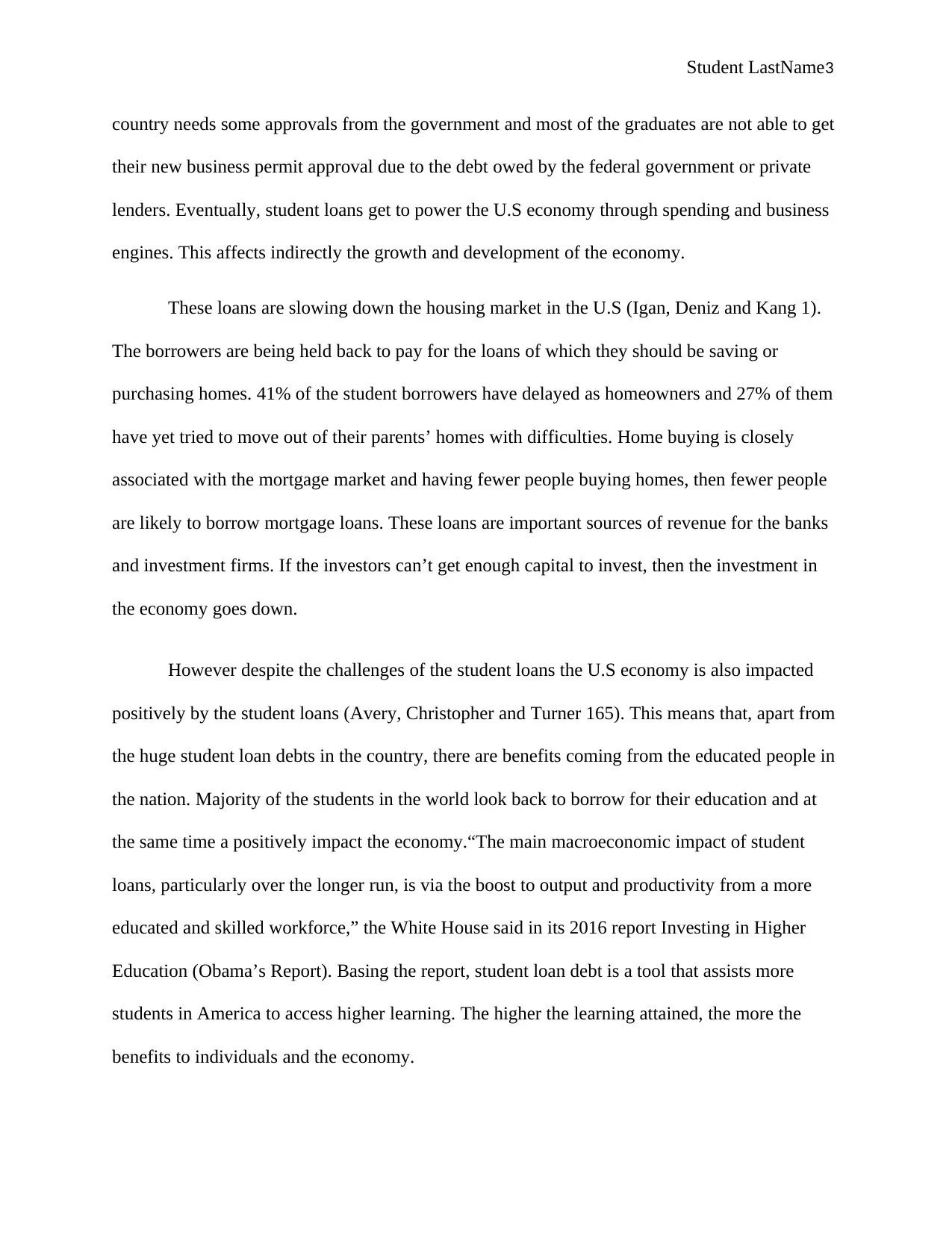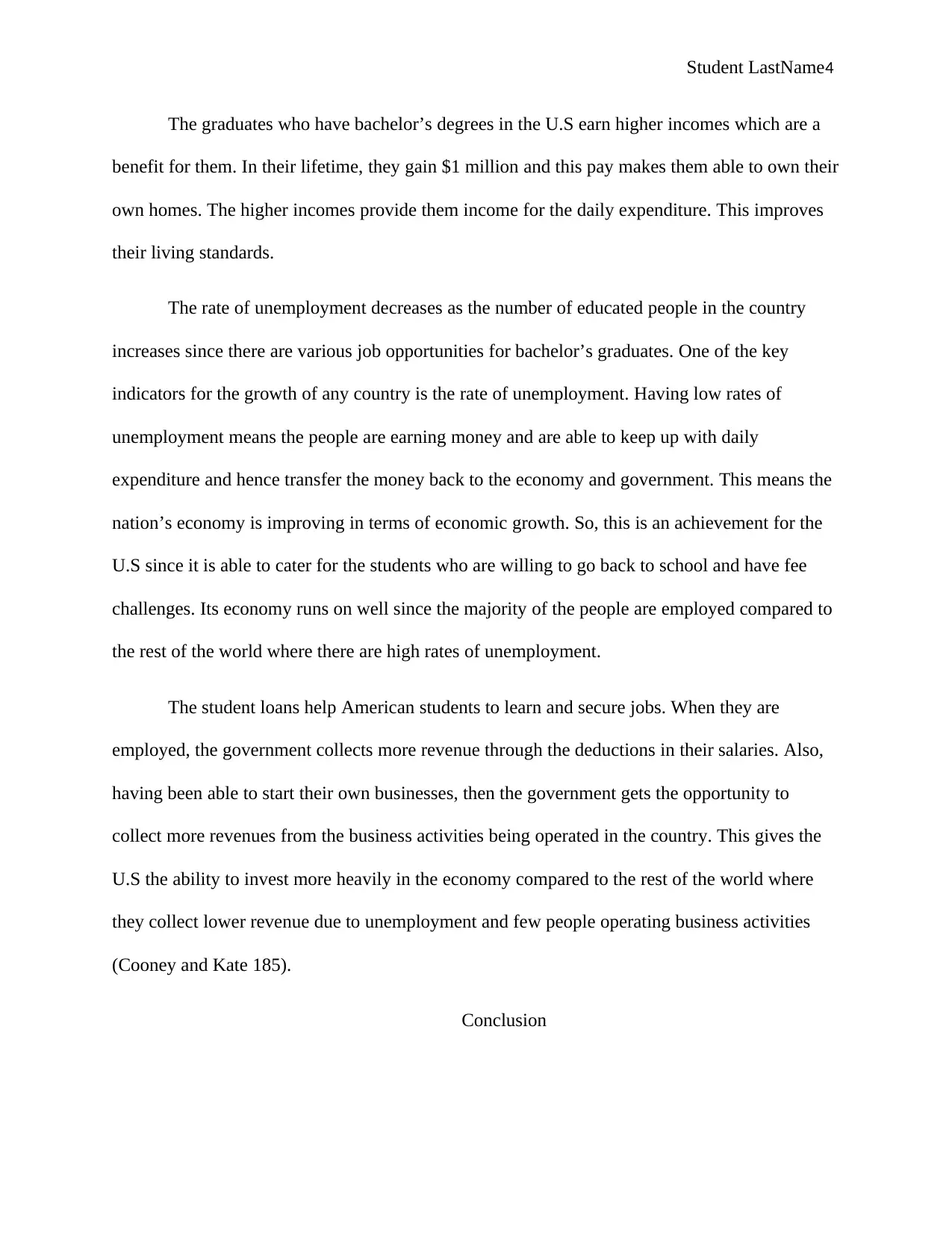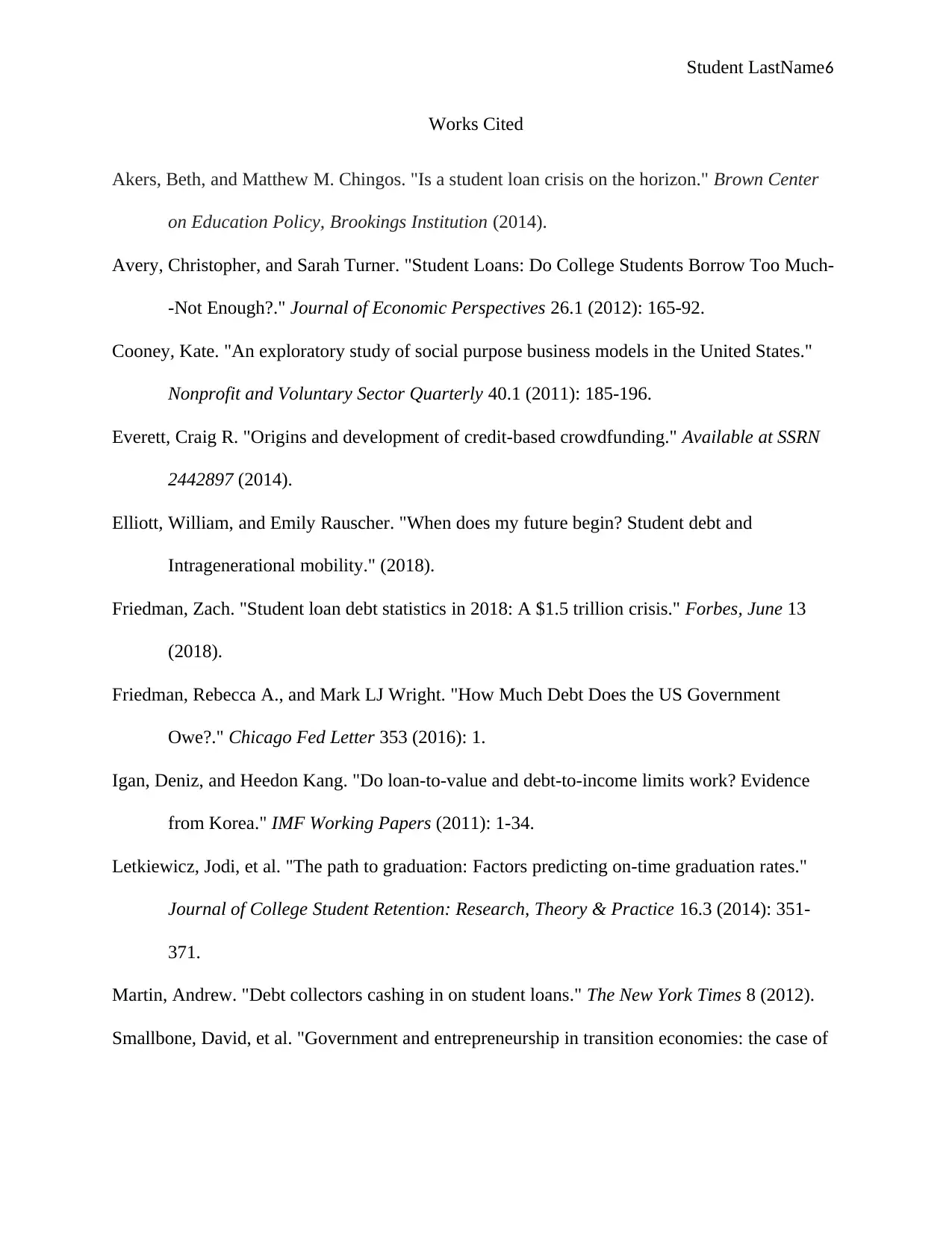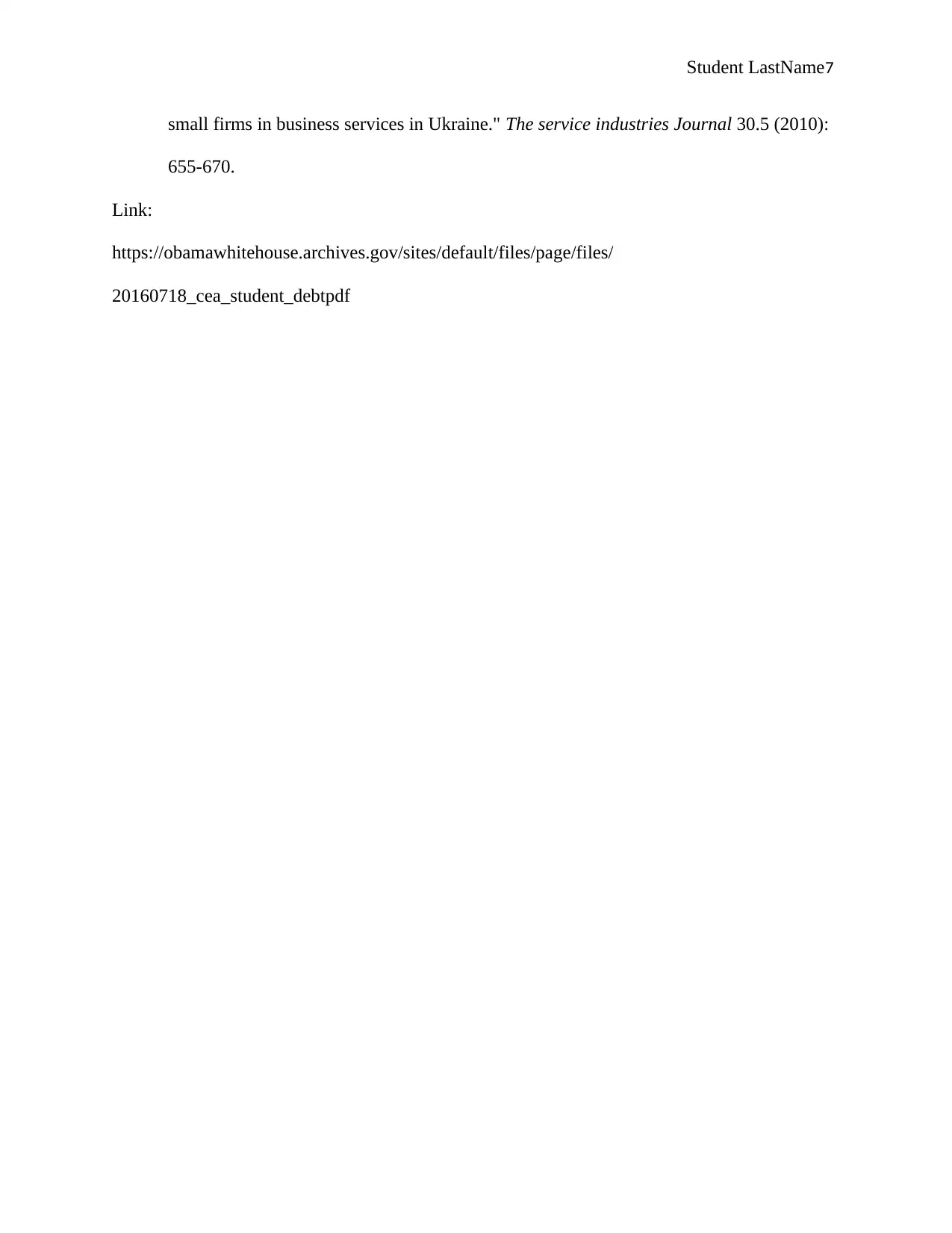An Investigation into Student Loans and the US Economic Landscape
VerifiedAdded on 2023/01/23
|7
|1957
|54
Essay
AI Summary
This essay provides an in-depth analysis of the multifaceted impact of student loans on the US economy. It begins by outlining the increasing prevalence of student loan debt in the United States and differentiates between federal and private loans. The essay explores the negative consequences of student debt, such as reduced consumer spending, delayed homeownership, and hindered business ventures, while also acknowledging the positive impacts of student loans, including increased access to higher education, a more skilled workforce, and higher earning potential for graduates. The essay further discusses the challenges student loan debt poses to the U.S. economy compared to other nations and its effects on the housing market. Ultimately, the essay concludes that while student loans provide opportunities for education, they simultaneously create significant economic challenges, particularly for the U.S. economy.

Student LastName1
Student Name
Instructor
Course
Date
Introduction
Student loans in the United States have been increasing since the 90s to 20s to cater for
the students who have challenges in paying for school fees in their colleges and universities
(Akers and Chingos). Federal and private student loans are the two sources of student loans
(Martin and Andrew 8). The federal loans are given out by the U.S government through the
education department. The private student loans are sponsored by banks and investors who use
the online platform as lenders and credit unions (Everett and Craig). After the students borrow
the loans, then they become a debt which should be paid back after their studies. In the U.S,
student loan debt has increased rapidly since the year 2004 and has reached $ 1.52 trillion in the
first quarter of 2018. This debt is anticipated to be higher than $ 1.52 trillion by the end of 2019
(Elliott, William and Rauscher). The student debt has influenced the U.S economy negatively
compared to that of the rest of the world as discussed.
Body
The number of graduates in the U.S who hold student loans was estimated to be 44
million during the year 2018 (Friedman and Zach). This number having held $1.52 trillion is a
big amount of money that can be used for developments in the country in order to foster its
Student Name
Instructor
Course
Date
Introduction
Student loans in the United States have been increasing since the 90s to 20s to cater for
the students who have challenges in paying for school fees in their colleges and universities
(Akers and Chingos). Federal and private student loans are the two sources of student loans
(Martin and Andrew 8). The federal loans are given out by the U.S government through the
education department. The private student loans are sponsored by banks and investors who use
the online platform as lenders and credit unions (Everett and Craig). After the students borrow
the loans, then they become a debt which should be paid back after their studies. In the U.S,
student loan debt has increased rapidly since the year 2004 and has reached $ 1.52 trillion in the
first quarter of 2018. This debt is anticipated to be higher than $ 1.52 trillion by the end of 2019
(Elliott, William and Rauscher). The student debt has influenced the U.S economy negatively
compared to that of the rest of the world as discussed.
Body
The number of graduates in the U.S who hold student loans was estimated to be 44
million during the year 2018 (Friedman and Zach). This number having held $1.52 trillion is a
big amount of money that can be used for developments in the country in order to foster its
Paraphrase This Document
Need a fresh take? Get an instant paraphrase of this document with our AI Paraphraser

Student LastName2
economic growth. The student debt has negatively impacted the U.S economy but has enabled
the nation to sponsor its citizens to study especially those who face the school fee challenges.
The U.S economy is higher compared to the economies of the other nations in the world
like Japan, China, and German. This was shown by the Gross Domestic Product (GDP) in the
year 2016 where it was recorded to be $18 trillion which was as large as the combined GDPs for
the three nations which are Japan, China, and German (Friedman, Rebecca and Wright 353). The
student loan debt is highest in the U.S compared to that of the rest of the world and it has brought
some challenges in the economy. The U.S economy is being crippled by the student loan debt.
The student debt has interrupted the spending habit of the U.S graduates (Letkiewicz and
Jodi 351). Only a few of them are willing and able to buy cars and homes or have retirement
savings. The reason behind this is because most of their incomes are being used to pay for
student loans. The loans are consuming a lot of their income such that no other activity can be
driven with the remaining amount of money. This is decreasing the living standards of the U.S
people hence affecting the economy in a negative way. Similarly, the U.S is a consumer-driven
economy and it moves on or grows when people are paying for goods and services. Having
fewer people paying for the goods and services, then it implies that the revenues collected and
profits are less and can’t sustain the economy to continue growing.
The business activities are slowing down and others are being left pending (Smallbone
and David 655). This is because of the student loans since the people are contributing more to
those loans. This is making the small businesses or entrepreneurship to go down and these are
the activities that provide job opportunities and services that drive the country’s economy.
Besides these, recent graduates, actually one among the five, say their student loans are holding
them back on coming up with new businesses in the country. To start a new business in the
economic growth. The student debt has negatively impacted the U.S economy but has enabled
the nation to sponsor its citizens to study especially those who face the school fee challenges.
The U.S economy is higher compared to the economies of the other nations in the world
like Japan, China, and German. This was shown by the Gross Domestic Product (GDP) in the
year 2016 where it was recorded to be $18 trillion which was as large as the combined GDPs for
the three nations which are Japan, China, and German (Friedman, Rebecca and Wright 353). The
student loan debt is highest in the U.S compared to that of the rest of the world and it has brought
some challenges in the economy. The U.S economy is being crippled by the student loan debt.
The student debt has interrupted the spending habit of the U.S graduates (Letkiewicz and
Jodi 351). Only a few of them are willing and able to buy cars and homes or have retirement
savings. The reason behind this is because most of their incomes are being used to pay for
student loans. The loans are consuming a lot of their income such that no other activity can be
driven with the remaining amount of money. This is decreasing the living standards of the U.S
people hence affecting the economy in a negative way. Similarly, the U.S is a consumer-driven
economy and it moves on or grows when people are paying for goods and services. Having
fewer people paying for the goods and services, then it implies that the revenues collected and
profits are less and can’t sustain the economy to continue growing.
The business activities are slowing down and others are being left pending (Smallbone
and David 655). This is because of the student loans since the people are contributing more to
those loans. This is making the small businesses or entrepreneurship to go down and these are
the activities that provide job opportunities and services that drive the country’s economy.
Besides these, recent graduates, actually one among the five, say their student loans are holding
them back on coming up with new businesses in the country. To start a new business in the

Student LastName3
country needs some approvals from the government and most of the graduates are not able to get
their new business permit approval due to the debt owed by the federal government or private
lenders. Eventually, student loans get to power the U.S economy through spending and business
engines. This affects indirectly the growth and development of the economy.
These loans are slowing down the housing market in the U.S (Igan, Deniz and Kang 1).
The borrowers are being held back to pay for the loans of which they should be saving or
purchasing homes. 41% of the student borrowers have delayed as homeowners and 27% of them
have yet tried to move out of their parents’ homes with difficulties. Home buying is closely
associated with the mortgage market and having fewer people buying homes, then fewer people
are likely to borrow mortgage loans. These loans are important sources of revenue for the banks
and investment firms. If the investors can’t get enough capital to invest, then the investment in
the economy goes down.
However despite the challenges of the student loans the U.S economy is also impacted
positively by the student loans (Avery, Christopher and Turner 165). This means that, apart from
the huge student loan debts in the country, there are benefits coming from the educated people in
the nation. Majority of the students in the world look back to borrow for their education and at
the same time a positively impact the economy.“The main macroeconomic impact of student
loans, particularly over the longer run, is via the boost to output and productivity from a more
educated and skilled workforce,” the White House said in its 2016 report Investing in Higher
Education (Obama’s Report). Basing the report, student loan debt is a tool that assists more
students in America to access higher learning. The higher the learning attained, the more the
benefits to individuals and the economy.
country needs some approvals from the government and most of the graduates are not able to get
their new business permit approval due to the debt owed by the federal government or private
lenders. Eventually, student loans get to power the U.S economy through spending and business
engines. This affects indirectly the growth and development of the economy.
These loans are slowing down the housing market in the U.S (Igan, Deniz and Kang 1).
The borrowers are being held back to pay for the loans of which they should be saving or
purchasing homes. 41% of the student borrowers have delayed as homeowners and 27% of them
have yet tried to move out of their parents’ homes with difficulties. Home buying is closely
associated with the mortgage market and having fewer people buying homes, then fewer people
are likely to borrow mortgage loans. These loans are important sources of revenue for the banks
and investment firms. If the investors can’t get enough capital to invest, then the investment in
the economy goes down.
However despite the challenges of the student loans the U.S economy is also impacted
positively by the student loans (Avery, Christopher and Turner 165). This means that, apart from
the huge student loan debts in the country, there are benefits coming from the educated people in
the nation. Majority of the students in the world look back to borrow for their education and at
the same time a positively impact the economy.“The main macroeconomic impact of student
loans, particularly over the longer run, is via the boost to output and productivity from a more
educated and skilled workforce,” the White House said in its 2016 report Investing in Higher
Education (Obama’s Report). Basing the report, student loan debt is a tool that assists more
students in America to access higher learning. The higher the learning attained, the more the
benefits to individuals and the economy.
⊘ This is a preview!⊘
Do you want full access?
Subscribe today to unlock all pages.

Trusted by 1+ million students worldwide

Student LastName4
The graduates who have bachelor’s degrees in the U.S earn higher incomes which are a
benefit for them. In their lifetime, they gain $1 million and this pay makes them able to own their
own homes. The higher incomes provide them income for the daily expenditure. This improves
their living standards.
The rate of unemployment decreases as the number of educated people in the country
increases since there are various job opportunities for bachelor’s graduates. One of the key
indicators for the growth of any country is the rate of unemployment. Having low rates of
unemployment means the people are earning money and are able to keep up with daily
expenditure and hence transfer the money back to the economy and government. This means the
nation’s economy is improving in terms of economic growth. So, this is an achievement for the
U.S since it is able to cater for the students who are willing to go back to school and have fee
challenges. Its economy runs on well since the majority of the people are employed compared to
the rest of the world where there are high rates of unemployment.
The student loans help American students to learn and secure jobs. When they are
employed, the government collects more revenue through the deductions in their salaries. Also,
having been able to start their own businesses, then the government gets the opportunity to
collect more revenues from the business activities being operated in the country. This gives the
U.S the ability to invest more heavily in the economy compared to the rest of the world where
they collect lower revenue due to unemployment and few people operating business activities
(Cooney and Kate 185).
Conclusion
The graduates who have bachelor’s degrees in the U.S earn higher incomes which are a
benefit for them. In their lifetime, they gain $1 million and this pay makes them able to own their
own homes. The higher incomes provide them income for the daily expenditure. This improves
their living standards.
The rate of unemployment decreases as the number of educated people in the country
increases since there are various job opportunities for bachelor’s graduates. One of the key
indicators for the growth of any country is the rate of unemployment. Having low rates of
unemployment means the people are earning money and are able to keep up with daily
expenditure and hence transfer the money back to the economy and government. This means the
nation’s economy is improving in terms of economic growth. So, this is an achievement for the
U.S since it is able to cater for the students who are willing to go back to school and have fee
challenges. Its economy runs on well since the majority of the people are employed compared to
the rest of the world where there are high rates of unemployment.
The student loans help American students to learn and secure jobs. When they are
employed, the government collects more revenue through the deductions in their salaries. Also,
having been able to start their own businesses, then the government gets the opportunity to
collect more revenues from the business activities being operated in the country. This gives the
U.S the ability to invest more heavily in the economy compared to the rest of the world where
they collect lower revenue due to unemployment and few people operating business activities
(Cooney and Kate 185).
Conclusion
Paraphrase This Document
Need a fresh take? Get an instant paraphrase of this document with our AI Paraphraser

Student LastName5
The student loans in the U.S are good to some extent for the economy and at the same
time have a negative implication on the economy. Most of the world’s countries don’t have much
higher student debts as compared to the U.S. These student debts slow economic growth and
development in the U.S as compared to that of the rest in the world. The U.S economy is vast
and contributes much towards the world economic growth as compared to other nations.
Most of the developed countries in the world are better off to in giving the students loans
as their economies are highly developed. This makes the majority of the citizens to acquire the
right skills required in the job market. For developing countries, it is a challenge to provide such
loans to the students. It is good to sponsor people having school fee challenges but not in huge
numbers unless a nation has private investors who can lend the students money. It is a big
challenge for these countries to have such debts as they may not be able to run their economies.
Majority of the students in the underdeveloped and developing countries have to suffer since the
sources for the school fee sponsorship are limited.
Lastly, the student loans are good for the countries which have already developed due to
large debt occurring from the borrowers. For the developed countries, jobs are readily available
and when students graduate are assured of getting a job, unlike the developing and
underdeveloped countries’ graduates.
The student loans in the U.S are good to some extent for the economy and at the same
time have a negative implication on the economy. Most of the world’s countries don’t have much
higher student debts as compared to the U.S. These student debts slow economic growth and
development in the U.S as compared to that of the rest in the world. The U.S economy is vast
and contributes much towards the world economic growth as compared to other nations.
Most of the developed countries in the world are better off to in giving the students loans
as their economies are highly developed. This makes the majority of the citizens to acquire the
right skills required in the job market. For developing countries, it is a challenge to provide such
loans to the students. It is good to sponsor people having school fee challenges but not in huge
numbers unless a nation has private investors who can lend the students money. It is a big
challenge for these countries to have such debts as they may not be able to run their economies.
Majority of the students in the underdeveloped and developing countries have to suffer since the
sources for the school fee sponsorship are limited.
Lastly, the student loans are good for the countries which have already developed due to
large debt occurring from the borrowers. For the developed countries, jobs are readily available
and when students graduate are assured of getting a job, unlike the developing and
underdeveloped countries’ graduates.

Student LastName6
Works Cited
Akers, Beth, and Matthew M. Chingos. "Is a student loan crisis on the horizon." Brown Center
on Education Policy, Brookings Institution (2014).
Avery, Christopher, and Sarah Turner. "Student Loans: Do College Students Borrow Too Much-
-Not Enough?." Journal of Economic Perspectives 26.1 (2012): 165-92.
Cooney, Kate. "An exploratory study of social purpose business models in the United States."
Nonprofit and Voluntary Sector Quarterly 40.1 (2011): 185-196.
Everett, Craig R. "Origins and development of credit-based crowdfunding." Available at SSRN
2442897 (2014).
Elliott, William, and Emily Rauscher. "When does my future begin? Student debt and
Intragenerational mobility." (2018).
Friedman, Zach. "Student loan debt statistics in 2018: A $1.5 trillion crisis." Forbes, June 13
(2018).
Friedman, Rebecca A., and Mark LJ Wright. "How Much Debt Does the US Government
Owe?." Chicago Fed Letter 353 (2016): 1.
Igan, Deniz, and Heedon Kang. "Do loan-to-value and debt-to-income limits work? Evidence
from Korea." IMF Working Papers (2011): 1-34.
Letkiewicz, Jodi, et al. "The path to graduation: Factors predicting on-time graduation rates."
Journal of College Student Retention: Research, Theory & Practice 16.3 (2014): 351-
371.
Martin, Andrew. "Debt collectors cashing in on student loans." The New York Times 8 (2012).
Smallbone, David, et al. "Government and entrepreneurship in transition economies: the case of
Works Cited
Akers, Beth, and Matthew M. Chingos. "Is a student loan crisis on the horizon." Brown Center
on Education Policy, Brookings Institution (2014).
Avery, Christopher, and Sarah Turner. "Student Loans: Do College Students Borrow Too Much-
-Not Enough?." Journal of Economic Perspectives 26.1 (2012): 165-92.
Cooney, Kate. "An exploratory study of social purpose business models in the United States."
Nonprofit and Voluntary Sector Quarterly 40.1 (2011): 185-196.
Everett, Craig R. "Origins and development of credit-based crowdfunding." Available at SSRN
2442897 (2014).
Elliott, William, and Emily Rauscher. "When does my future begin? Student debt and
Intragenerational mobility." (2018).
Friedman, Zach. "Student loan debt statistics in 2018: A $1.5 trillion crisis." Forbes, June 13
(2018).
Friedman, Rebecca A., and Mark LJ Wright. "How Much Debt Does the US Government
Owe?." Chicago Fed Letter 353 (2016): 1.
Igan, Deniz, and Heedon Kang. "Do loan-to-value and debt-to-income limits work? Evidence
from Korea." IMF Working Papers (2011): 1-34.
Letkiewicz, Jodi, et al. "The path to graduation: Factors predicting on-time graduation rates."
Journal of College Student Retention: Research, Theory & Practice 16.3 (2014): 351-
371.
Martin, Andrew. "Debt collectors cashing in on student loans." The New York Times 8 (2012).
Smallbone, David, et al. "Government and entrepreneurship in transition economies: the case of
⊘ This is a preview!⊘
Do you want full access?
Subscribe today to unlock all pages.

Trusted by 1+ million students worldwide

Student LastName7
small firms in business services in Ukraine." The service industries Journal 30.5 (2010):
655-670.
Link:
https://obamawhitehouse.archives.gov/sites/default/files/page/files/
20160718_cea_student_debtpdf
small firms in business services in Ukraine." The service industries Journal 30.5 (2010):
655-670.
Link:
https://obamawhitehouse.archives.gov/sites/default/files/page/files/
20160718_cea_student_debtpdf
1 out of 7
Your All-in-One AI-Powered Toolkit for Academic Success.
+13062052269
info@desklib.com
Available 24*7 on WhatsApp / Email
![[object Object]](/_next/static/media/star-bottom.7253800d.svg)
Unlock your academic potential
Copyright © 2020–2025 A2Z Services. All Rights Reserved. Developed and managed by ZUCOL.
